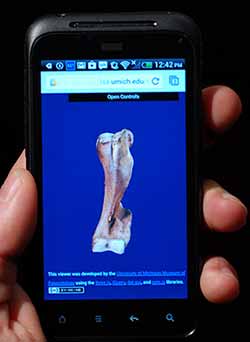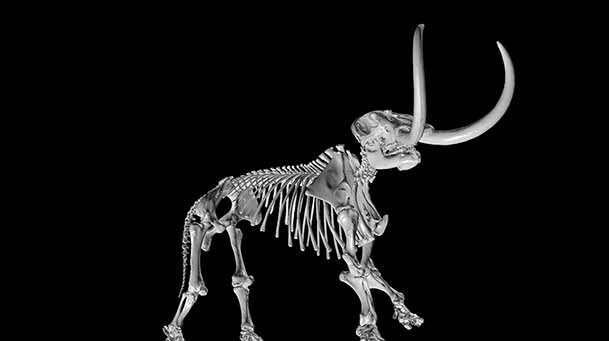University of Michigan paleontologist Daniel Fisher has a bone to pick — and he’s using the Internet to do it.
Actually, Fisher is using the Internet to allows others to pick bones — hundreds of them, all fossilized and digitally scanned for presentation in three dimensions. It’s a project Fisher started two decades ago. And thanks to several recent technical advances, U-M’s Museum of Paleontology is now host to the University of Michigan Online Repository of Fossils.
“On this website we’ll be providing 3-D models that allow you to manipulate these objects onscreen and to do very much what we would do if we had the real specimen in our own hands — zoom in on it, rotate it this way and that, and even make measurements of it,” says Fisher, the museum’s director.
Initially intended as a tool to help field paleontologists identify fossils, the powerful new resource also is expected to have wide appeal to students and the general public, he notes. The number of 3-D bone models on the new website is expected to grow into the thousands as additional specimens are uploaded.
Picked apart
The new U-M website is not the first online paleontology collection, but it has features unmatched by any previous effort. The resolution of the images is higher, and viewers have the ability to use a “BonePicker” tool to pull individual bones from a skeleton and examine photorealistic 3-D versions of those bones up close.
3-D bones from elephant-like mammoths and mastodons are available on the site, along with photo galleries of early whales and other vertebrates. Three-dimensional digital models of various ancient marine invertebrates — brachiopods, trilobites, clams, crinoids, snails, and others — are coming soon.
“In many cases, especially for smaller specimens, you can see a lot more detail on the screen than you could if you were holding it in your hand,” says Dan Miller, invertebrate paleontology collections manager at the museum. On the computer monitor in front of him is a large, crisp color image of a clam-like brachiopod that lived on the sea bottom some 390 million years ago.
“Keep in mind that this specimen, which is maybe 7 or 8 inches on the screen, is really only an inch-and-a-half in size,” Miller says. “If I had it in my hand right now, I wouldn’t be able to see half of the detail that I see here on this screen.”

3-D digital model of a femur (thighbone) from the Buesching mastodon as it appears on the new website. (Image courtesy of the U-M Museum of Paleontology.)
The site opens a host of options for future collaborations, Miller says. Research museums often loan specimens to other scientists, raising the possibility that one-of-a-kind objects could be damaged or lost. It’s also expensive to ship large, heavy bones. Sharing the museum’s collection online is far more practical.
“This new website makes doing science more efficient, increasing access to the collections while protecting invaluable specimens,” Miller says.
Dig this
Three recent advances made the U-M project feasible, notes Adam Rountrey, collections manager for vertebrates at the museum and lead developer of the digital viewer that presents the 3-D models on the website.
The advent of handheld digital scanners enabled the team to quickly capture extremely high-definition 3-D models of bones and other fossilized remains. The ability to digitally drape high-quality photographs of the bones onto the surface of the 3-D models allowed for photorealistic 3-D portrayal of specimens. And increased web browser support for 3-D content means that almost anyone with a computer and Internet access can view the models.
“This will be invaluable to a researcher who has found an unidentified bone in the field,” Fisher says. “The mastodon foot has about 35 bones, and some are not very distinctive. Using this tool, you can see the structure of the whole foot, then go in and pick out an individual bone and examine it closely, then look at the next one and the next one until you figure out what you have.”
Elephant in the room
The just-launched website includes a mastodon skeleton assembled from 245 bones painstakingly scanned into the computer by Fisher and his students. To help them properly align all the pieces, the researchers — with help from Brandon Walker of Midwestern Consulting — digitally scanned the mounted Buesching mastodon skeleton on display at the U-M Museum of Natural History, then used it as a guide.
Visitors to the website can double-click on any bone in the mastodon skeleton to get a separate close-up image that can be rotated, zoomed, panned, and even measured. It’s perfect for the researcher working in a remote excavation site or the aspiring paleontologist who is just beginning to explore.
“None of what we’re doing now was possible when this all began,” Fisher says. “Simply being able to zoom in and explore all of this anatomy is an opportunity that could easily arouse interest in young scientists-to-be.”
This spring Fisher gave a presentation about the project in Greece at the VIth International Conference on Mammoths and their Relatives. All of the Museum of Paleontology’s scientists and staff members contributed to the project.
(Top image: 3-D digital skeleton of an adult male mastodon, part of the new University of Michigan Online Repository of Fossils website. A mounted cast of the Buesching mastodon skeleton, which is on display at the U-M Museum of Natural History, was used to align the nearly 250 bones in the 3-D digital skeleton. Image courtesy of the U-M Museum of Paleontology.)




Bob Shapiro - 1981
Very cool, even for those of us who are just curious.
Reply